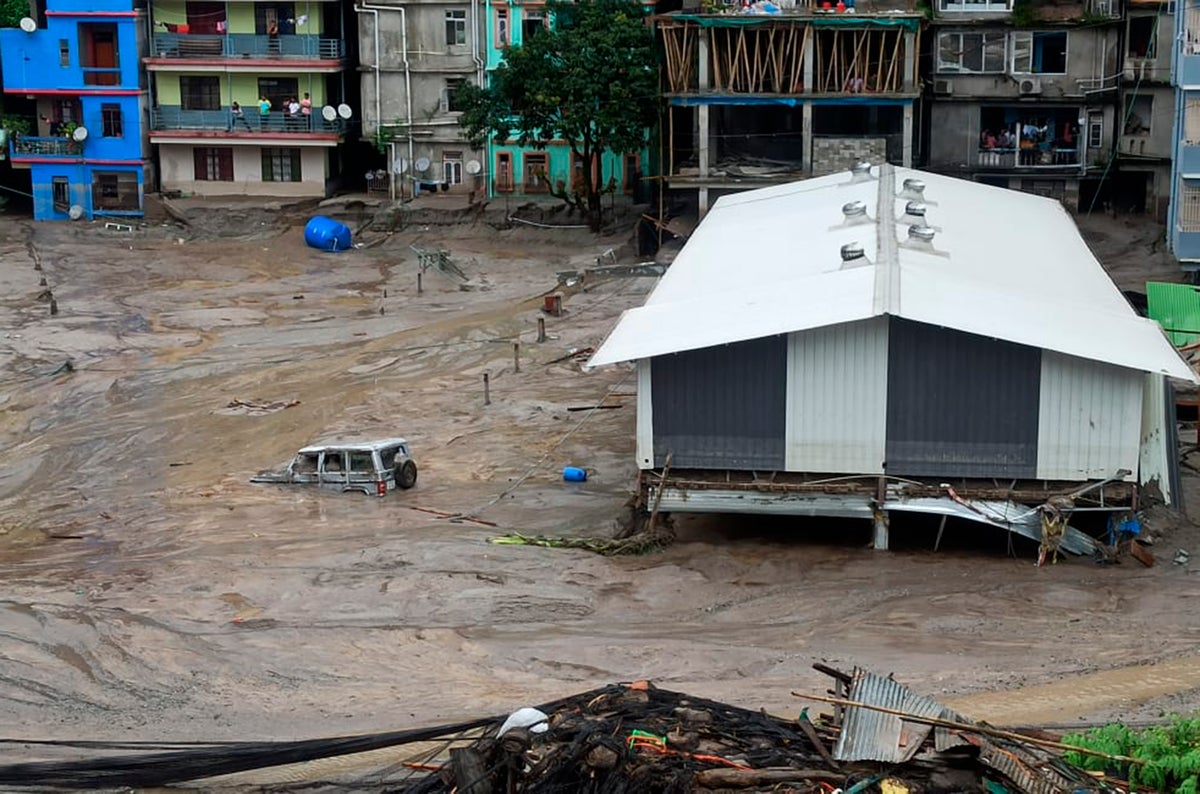
A flood that burst through a major hydroelectric dam in India's Himalayan northeast killed at least 31 people, officials said Friday, as ice-cold water swept through mountain towns, washing away houses and bridges and forcing thousands of people to leave their homes.
The flood began shortly after midnight Wednesday, when a glacial lake high in the mountains overflowed after a heavy rainfall. The waters cracked open a 6-year-old dam that was the largest in the Indian state of Sikkim, and then cascaded through towns in the Lachan Valley below.
It was the latest deadly flood to hit northeast India in a year of unusually heavy monsoon rains. Nearly 50 people died in flash floods and landslides in August in nearby Himachal Pradesh state, record rains in July killed more than 100 people over two weeks in northern India.
The design and placement of the Teesta-3 dam were controversial from the time it was built, part of an Indian government push to expand hydropower energy. Local activists argued that extreme weather caused by climate changes makes dam-building in the Himalayas too dangerous.
“Despite being the biggest project in the state, there were no early warning systems installed even though the glacier overflowing was a known risk,” said Himanshu Thakkar of the non-governmental organization South Asian Network for Rivers, Dams and People.
According to a release from India’s National Disaster Management Agency Friday, they plan to set up early warning systems for real-time alerts at most of India's 56 known at-risk glacial lakes.
Thakkar said authorities failed to apply the lessons from a 2021 dam breach in Himalayan state of Uttarakhand that killed 81 people, allowing an “eerily similar” disaster to occur.
The dam’s operator, and local agencies responsible for dam safety, did not respond to requests for comment Friday.
In 2021, the Indian federal government passed a dam safety law that requires operators and local governments to plan for emergencies, but the Teesta-3 dam is not listed as being monitored for safety by India’s chief dam regulator, the Central Water Commission.
A 2021 study warned that the dam posed a growing risk of catastrophic floods. South Lhonak Lake has been rising in recent years as a warming climate melts the glaciers that feed it, putting pressure on the dam, but it wasn’t clear what triggered the breach Wednesday.
Experts and varying government reports have pointed to sudden, intense rains in the area, and a 6.2 magnitude earthquake that struck nearby Nepal on Tuesday afternoon.
“We knew that this was coming,” said Gyatso Lepcha, general secretary of Affected Citizens of Teesta, an environmental organization based in Sikkim. “The same can happen with other dams also,” he wrote, in a statement that called for a safety review of all dams in the state.
More than 2,000 people were rescued after Wednesday’s floods, the Sikkim State Disaster Management Authority said in a statement, adding that state authorities set up 26 relief camps for more than 22,000 people impacted by the floods.
Rescue workers were still searching for nearly 100 missing people, including 22 soldiers, on Thursday, according to the Sikkim state government.
Vinay Bhushan Pathak, the state's top bureaucrat, said that 26 people had been taken to hospitals with injuries, while nearly 3,000 tourists were stranded in the flood-hit areas along with 700 taxi drivers.
“We are evacuating them through helicopters provided by the army and the air force,” he said.
Eleven bridges in the Lachan Valley were washed away by the floodwaters, which also hit pipelines and damaged or destroyed more than 270 houses in four districts, officials said.
Several towns, including Dikchu and Rangpo in the Teesta basin, were flooded, and schools in four districts were ordered shut until Sunday, the state’s education department said.
Parts of a highway that links Sikkim, the state capital, with the rest of the country were also washed away.
The floods also hit several army camps, burying vehicles in feet of mud, according to images released by the Indian military.
The Press Trust of India news agency cited a statement by neighboring West Bengal state as saying that the bodies of four soldiers were found. However, it wasn’t immediately clear whether they were among the 22 missing soldiers, or had died separately.
One soldier who had been reported missing on Wednesday was later rescued by authorities, the army said in a statement.
The army is providing medical aid and phone connectivity to civilians in the areas of Chungthang, Lachung and Lachen in north Sikkim, the army statement said.
Prime Minister Narendra Modi’s office said in a statement that the government would support state authorities in the aftermath of the flooding.
The Teesta 3 hydropower project, built on the Teesta River, took nine years and cost $1.5 billion to construct. The project was capable of producing 1,200 megawatts of electricity — enough to power 1.5 million Indian homes — and began operations in 2017.
Despite risks to dams due to increasing frequency of extreme weather, the Indian federal government aims to increase India’s hydroelectric dam output by half, to 70,000 megawatts, by 2030.
Disasters caused by landslides and floods are common in India’s Himalayan region during the June-September monsoon season. Scientists say they are becoming more frequent as global warming contributes to the melting of glaciers there.
“This is, incredibly sadly, another classic case of a cascading hazard chain that amplifies as you go downstream,” said Jakob Steiner, a climate scientist with the International Center for Integrated Mountain Development, commenting on Wednesday's flash flooding.
Earlier this year, Steiner’s organization published a report saying that Himalayan glaciers could lose 80% of their volume if global warming isn’t controlled.
Last month, dam breaches caused by Storm Daniel caused devastating damage to the city of Derna in Libya.
___
Arasu reported from Bengaluru, India.







